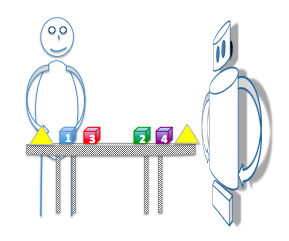|
|
|
FJA@RSS2018 > BenchmarkWe seek to build a benchmark, an illustrative example that would serve as a common basis for discussion. Below, you will find a first proposal regarding this goal. It needs to be improved and discussed (e.g. letting room for norms definition or social context). However, we think it is crucial, to capture the subtlety of the work of each other and to built a common ground regarding the subject we want to tackle. Feel free to contact us: fja@sciencesconf.org if you want to propose any improvement or modification. Thanks. An illustrative examplePlease feel free to play with this example since discussion is really welcome. However, it would be very useful if you clearly indicate in what way your work is helpful to deal with such an example, i.e. which "brick" your work could contribute to the framework. A human and a robot have the goal to build a pile with 4 cubes and put a triangle at the top. One after the other, they should stack bricks in the expected order.Each agent has a number of cubes accessible in front of him and would participate to the task by placing its cubes on the pile. At the end, one of the agent should place a triangle at the top of the pile. The initial state is the following: Actions available for each agent are the following (with object = cube or triangle):
Each agent is able to infer the state of the world so it knows:
Moreover, we assume each agent is able to observe the activity of the other. The expected final state could be one of the following:
Possible deviations could be that:
Moreover, during the execution of the task, a number of behaviors can arise, among all:
Finally, a negotiation phase should arise at the end to decide who put the triangle on the pile.
Scenario enhancement propositions:(please to do not hesitate to do other propositions) 1) Have more variability in the task: There should be more places where a choice is needed between the human or the robot to do the task. We could think that at the beginning each agent have all bricks available (so we would have two bricks 1, 2, 3 and 4, one for each for example) 2) Introduce social aspect in the task: We could think to have several human "types" given their age or their (previous) knowledge. TopicsWe are seeking to frame joint action, interesting topics include (but are not restricted to):
|





